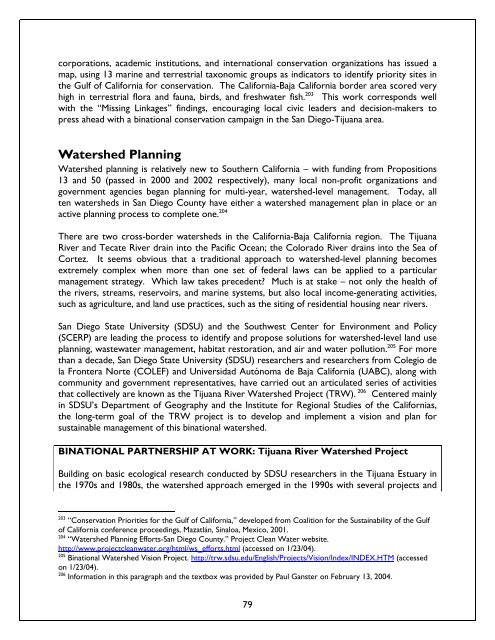Blurred Borders - International Community Foundation
Blurred Borders - International Community Foundation
Blurred Borders - International Community Foundation
Create successful ePaper yourself
Turn your PDF publications into a flip-book with our unique Google optimized e-Paper software.
corporations, academic institutions, and international conservation organizations has issued a<br />
map, using 13 marine and terrestrial taxonomic groups as indicators to identify priority sites in<br />
the Gulf of California for conservation. The California-Baja California border area scored very<br />
high in terrestrial flora and fauna, birds, and freshwater fish. 203 This work corresponds well<br />
with the “Missing Linkages” findings, encouraging local civic leaders and decision-makers to<br />
press ahead with a binational conservation campaign in the San Diego-Tijuana area.<br />
Watershed Planning<br />
Watershed planning is relatively new to Southern California – with funding from Propositions<br />
13 and 50 (passed in 2000 and 2002 respectively), many local non-profit organizations and<br />
government agencies began planning for multi-year, watershed-level management. Today, all<br />
ten watersheds in San Diego County have either a watershed management plan in place or an<br />
active planning process to complete one. 204<br />
There are two cross-border watersheds in the California-Baja California region. The Tijuana<br />
River and Tecate River drain into the Pacific Ocean; the Colorado River drains into the Sea of<br />
Cortez. It seems obvious that a traditional approach to watershed-level planning becomes<br />
extremely complex when more than one set of federal laws can be applied to a particular<br />
management strategy. Which law takes precedent? Much is at stake – not only the health of<br />
the rivers, streams, reservoirs, and marine systems, but also local income-generating activities,<br />
such as agriculture, and land use practices, such as the siting of residential housing near rivers.<br />
San Diego State University (SDSU) and the Southwest Center for Environment and Policy<br />
(SCERP) are leading the process to identify and propose solutions for watershed-level land use<br />
planning, wastewater management, habitat restoration, and air and water pollution. 205 For more<br />
than a decade, San Diego State University (SDSU) researchers and researchers from Colegio de<br />
la Frontera Norte (COLEF) and Universidad Autónoma de Baja California (UABC), along with<br />
community and government representatives, have carried out an articulated series of activities<br />
that collectively are known as the Tijuana River Watershed Project (TRW). 206 Centered mainly<br />
in SDSU’s Department of Geography and the Institute for Regional Studies of the Californias,<br />
the long-term goal of the TRW project is to develop and implement a vision and plan for<br />
sustainable management of this binational watershed.<br />
BINATIONAL PARTNERSHIP AT WORK: Tijuana River Watershed Project<br />
Building on basic ecological research conducted by SDSU researchers in the Tijuana Estuary in<br />
the 1970s and 1980s, the watershed approach emerged in the 1990s with several projects and<br />
203<br />
“Conservation Priorities for the Gulf of California,” developed from Coalition for the Sustainability of the Gulf<br />
of California conference proceedings, Mazatlán, Sinaloa, Mexico, 2001.<br />
204<br />
“Watershed Planning Efforts-San Diego County.” Project Clean Water website.<br />
http://www.projectcleanwater.org/html/ws_efforts.html (accessed on 1/23/04).<br />
205<br />
Binational Watershed Vision Project. http://trw.sdsu.edu/English/Projects/Vision/Index/INDEX.HTM (accessed<br />
on 1/23/04).<br />
206<br />
Information in this paragraph and the textbox was provided by Paul Ganster on February 13, 2004.<br />
79















